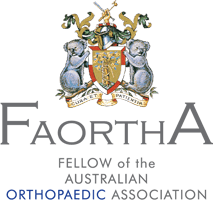Introduction
A bursa is a small fluid-filled sac that reduces friction by providing cushioning between bones, tendons and muscles throughout the body. Trochanteric bursitis is inflammation of the bursa covering the greater trochanter which is the outer bony point of the hip.
Trochanteric bursitis can occur in anyone, but it is more common in females and is more common with advancing age.
Causes
One or more of the following risk factors can contribute to the development of trochanteric bursitis:
- Repetitive overuse injury to the hip – trochanteric bursitis can occur as a result of running, climbing stairs, cycling or standing for long periods.
- Direct injury to the point of the hip – trochanteric bursitis can develop from a simple bump or fall onto the hip, or from lying on your side for long periods.
- Structural abnormalities – incorrect posture (due to spine disease) or abnormal stresses (due to inequal leg lengths) can contribute to the development of trochanteric bursitis.
- Hip surgery – previous surgery on and around the hip, with or without surgical implants, may lead to inflammation of the trochanteric bursa.
- Gluteal tendinopathy – aging, overuse and degeneration of the gluteal/buttock muscle attachments to the greater trochanter (bony point of the outer hip) can lead to greater trochanteric pain syndrome and trochanteric bursitis. Gluteal tendinopathy can progress to partial and full-thickness tears of the affected tendons.
- Other medical conditions – conditions such as rheumatoid arthritis, gout, psoriasis and psoriatic arthritis and thyroid dysfunction can contribute to the development of trochanteric bursitis.
Symptoms
Trochanteric bursitis usually causes pain over the outer aspect of the hip, that gradually deteriorates over time. Pain is worsened with activity and increased load. This pain may be sharp and sudden or may progress to more of a constant dull ache. The pain may radiate down the outer aspect of the thigh towards the knee.
The pain is usually worse at night, when lying directly on the side of the affected hip, when rising from a chair or getting out of a car, with prolonged sitting, or when sitting with crossed legs.
Tests
Imaging (x-ray, ultrasound or MRI) is only suggested if the diagnosis is in doubt, non-surgical measures have failed to relieve symptoms or gluteal tendinopathy and gluteal tendon tears are suspected after clinical examination.
Non-surgical treatment
The mainstay of treatment for trochanteric bursitis is non-surgical, aiming to reduce the pain and inflammation.
- Activity modification – minimising activities that exacerbate the symptoms, such as climbing stairs, sitting with legs crossed or high-impact exercise (e.g. running), may ease the pain and slow the worsening of symptoms.
- Medication – simple pain medication (such as paracetamol/Panadol) or Non-Steroidal Anti-Inflammatory Drugs (such as ibuprofen/Nurofen, meloxicam/Mobic, celecoxib/Celebrex) are often used when the pain and discomfort worsens, interferes with activities of daily living, or prevents a good night’s sleep.
- Exercise and physiotherapy – an exercise program focussing on stretching your gluteal, hamstring, hip external rotators and iliotibial band along with strengthening your core, gluteal and quadriceps musculature can help relieve the symptoms of trochanteric bursitis and prevent recurrence.
- Local anaesthetic + corticosteroid injection – an injection of local anaesthetic and corticosteroid into the inflamed bursa can both confirm the diagnosis and provide relief of symptoms. The pain relief may be temporary or permanent. These injections may be repeated every 3-4 months if required.





